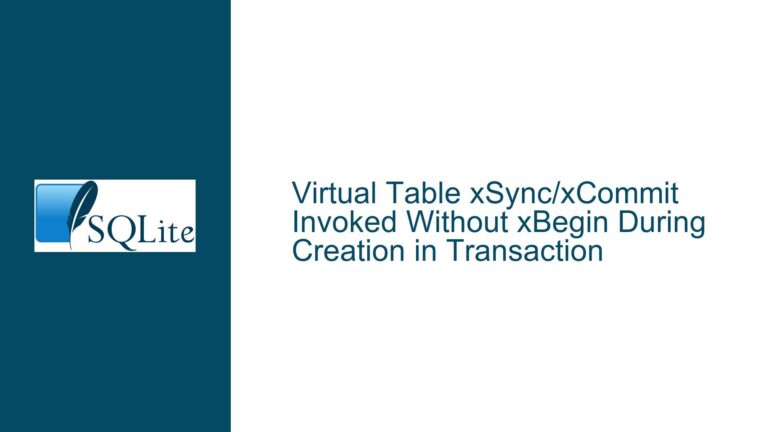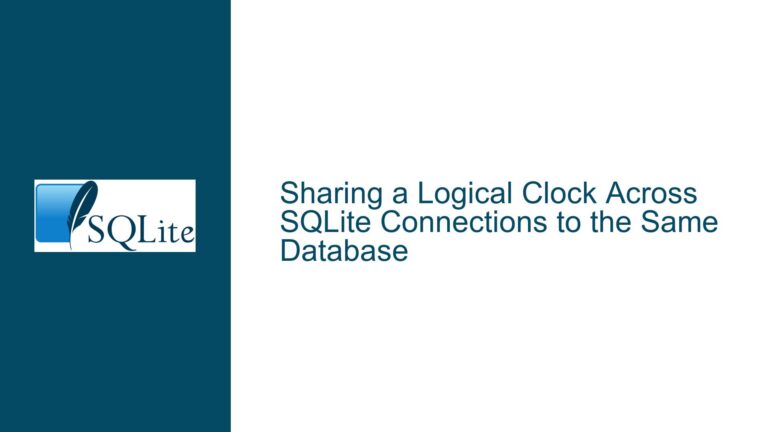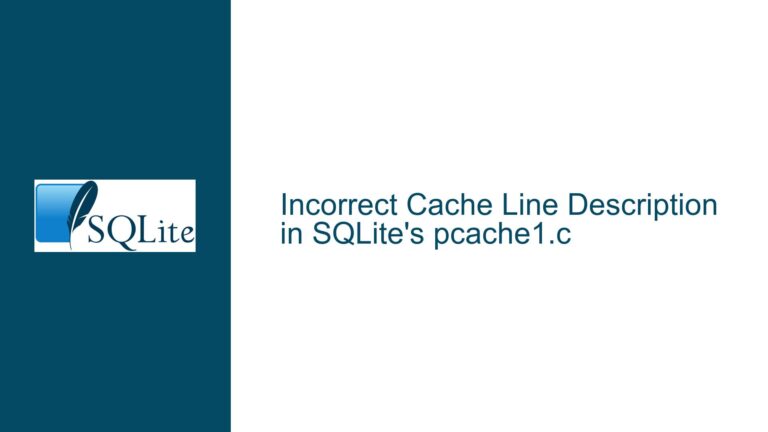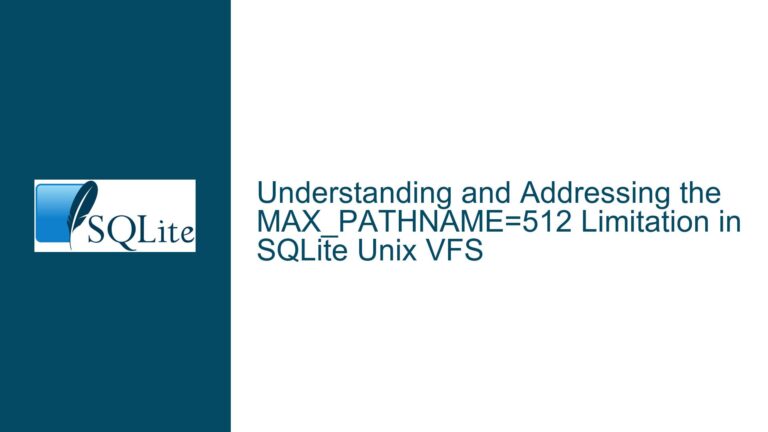SQLite Error Logger Invoked Spurious Schema Change Warnings
Schema Change Detection and Error Logger Invocation
Issue Overview
The core issue revolves around the SQLite error logging callback being invoked spuriously when a schema change is detected by another connection. This occurs even when the schema change is not an actual error from SQLite’s perspective. Specifically, when a connection prepares a statement that references a table that did not exist the last time the connection accessed the database, the error logger is invoked once. This happens despite SQLite not returning an error code to the caller, as the schema change is handled internally by SQLite.
The error logger is designed to provide debugging information, which is invaluable for tracking down obscure issues in applications. However, in this scenario, the logger is being triggered unnecessarily, leading to confusion and potential noise in the logs. The issue is particularly problematic because it forces developers to implement workarounds, such as filtering out these spurious messages, which increases application complexity and overhead.
The problem is reproducible across multiple SQLite versions (3.40.0, 3.45.2, and 3.46.1) and platforms (Windows and Linux). It does not require any special compile-time options to manifest. The issue is rooted in the way SQLite handles schema changes internally, specifically in the sqlite3Prepare function, which is called by sqlite3LockAndPrepare. When a schema change is detected, sqlite3Prepare invokes the error logger before returning SQLITE_SCHEMA, which triggers a schema reload. The second call to sqlite3Prepare then succeeds without invoking the logger.
Possible Causes
The spurious invocation of the error logger during schema changes can be attributed to several factors related to SQLite’s internal mechanisms for schema management and error handling.
First, SQLite’s schema change detection mechanism relies on the sqlite3Prepare function to detect changes in the database schema. When a connection prepares a statement that references a table or other schema object that has been modified or created by another connection, sqlite3Prepare initially treats this as an error condition. This is because the schema cached by the connection is now stale, and SQLite needs to reload the schema to ensure consistency.
During this process, sqlite3Prepare invokes the error logger, even though the schema change is not an actual error from the perspective of the application. This is because SQLite’s internal logic treats the initial detection of a schema change as an error condition, which triggers the logger. However, this is a false positive, as SQLite will subsequently reload the schema and retry the statement preparation, which will succeed without any issues.
Second, the error logger is designed to capture all error conditions, including those that are transient or handled internally by SQLite. This design choice ensures that developers have access to as much debugging information as possible. However, in the case of schema changes, this leads to unnecessary log entries that can clutter the logs and make it harder to identify genuine errors.
Third, the issue is exacerbated by the fact that SQLite does not provide a built-in mechanism to distinguish between genuine errors and transient schema change detections. This forces developers to implement their own filtering logic, which adds complexity to the application and increases the risk of introducing bugs.
Finally, the issue is more likely to occur in multi-threaded or multi-connection environments, where schema changes are more frequent. In such environments, the likelihood of one connection detecting a schema change made by another connection is higher, leading to more frequent spurious invocations of the error logger.
Troubleshooting Steps, Solutions & Fixes
To address the issue of spurious error logger invocations during schema changes, several approaches can be considered. These range from modifying the application code to work around the issue, to proposing changes to SQLite’s internal logic to handle schema changes more gracefully.
1. Filtering Error Logs in Application Code
One immediate workaround is to filter out the spurious error log entries in the application code. This can be done by examining the error codes and messages logged by the error logger and only emitting those that correspond to genuine errors. However, this approach has several drawbacks. It increases the complexity of the application code, introduces additional overhead, and requires careful handling to ensure that genuine errors are not inadvertently filtered out.
To implement this workaround, developers can modify the error logger callback to check the error code and message before emitting the log entry. For example, if the error code is SQLITE_ERROR and the message indicates a schema change, the log entry can be suppressed. However, this requires a deep understanding of SQLite’s error codes and messages, and may not be feasible in all cases.
2. Using a Custom Error Logger
Another approach is to implement a custom error logger that is aware of the specific issue and handles it appropriately. This custom logger can be designed to suppress log entries related to schema changes while still capturing genuine errors. This approach has the advantage of keeping the filtering logic separate from the main application code, reducing complexity and overhead.
To implement a custom error logger, developers can create a function that wraps the standard SQLite error logger and adds the necessary filtering logic. This function can then be registered as the error logger callback using the sqlite3_config function. The custom logger can be designed to check the error code and message, and only emit log entries for genuine errors.
3. Modifying SQLite’s Internal Logic
A more robust solution would be to modify SQLite’s internal logic to avoid invoking the error logger during schema change detection. This would require changes to the sqlite3Prepare function to distinguish between genuine errors and transient schema change detections. Specifically, the function could be modified to only invoke the error logger for genuine errors, and not for schema changes that are handled internally.
This approach would require a deep understanding of SQLite’s internal codebase and may not be feasible for all developers. However, it would provide a more elegant solution to the issue, as it would eliminate the need for application-level workarounds and ensure that the error logger only captures genuine errors.
4. Proposing Changes to the SQLite Development Team
Given that the issue is rooted in SQLite’s internal logic, another approach is to propose changes to the SQLite development team. This could involve submitting a patch or feature request that addresses the issue. The proposed changes could include modifications to the sqlite3Prepare function to avoid invoking the error logger during schema change detection, or the addition of a new API that allows developers to control the behavior of the error logger more precisely.
When proposing changes to the SQLite development team, it is important to provide a clear and detailed explanation of the issue, along with a reproducible test case. This will help the team understand the problem and evaluate the proposed changes. Additionally, it is important to consider the potential impact of the changes on existing applications and ensure that they do not introduce new issues.
5. Using Connection Pooling and Schema Versioning
In multi-threaded or multi-connection environments, another approach is to use connection pooling and schema versioning to minimize the likelihood of schema changes being detected by other connections. Connection pooling can help reduce the number of connections to the database, while schema versioning can help ensure that all connections are using the same version of the schema.
To implement connection pooling, developers can use a library or framework that provides connection pooling functionality, or implement their own connection pooling mechanism. Schema versioning can be implemented using the user_version pragma, as shown in the example code. By incrementing the user_version whenever the schema is modified, developers can ensure that all connections are aware of the latest schema version and reload the schema as needed.
6. Monitoring and Logging Best Practices
Finally, it is important to follow best practices for monitoring and logging in applications that use SQLite. This includes configuring the error logger appropriately, using structured logging to make it easier to filter and analyze log entries, and regularly reviewing the logs to identify and address any issues.
When configuring the error logger, developers should ensure that it is only enabled in environments where it is needed, such as during development and testing. In production environments, the error logger should be disabled or configured to only capture critical errors. Structured logging can be implemented using a logging library that supports structured log entries, such as JSON or key-value pairs. This makes it easier to filter and analyze log entries, and can help reduce the impact of spurious log entries.
Conclusion
The issue of spurious error logger invocations during schema changes in SQLite is a complex one that requires careful consideration of the underlying causes and potential solutions. While there are several workarounds that can be implemented in application code, the most robust solution would be to modify SQLite’s internal logic to avoid invoking the error logger during schema change detection. This would require changes to the SQLite codebase and may involve proposing changes to the SQLite development team.
In the meantime, developers can use a combination of filtering, custom error loggers, connection pooling, and schema versioning to minimize the impact of the issue. By following best practices for monitoring and logging, developers can ensure that their applications are able to handle schema changes gracefully and avoid being overwhelmed by spurious log entries.






